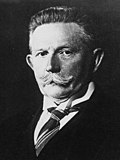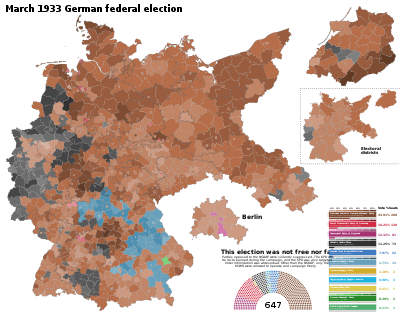
Back الانتخابات الفيدرالية الألمانية مارس 1933 Arabic Парламенцкія выбары ў Германіі (1933, сакавік) Byelorussian Eleccions federals alemanyes de març de 1933 Catalan Německé volby do říšského sněmu 1933 (březen) Czech Valget til den tyske rigsdag 1933 Danish Reichstagswahl März 1933 German Γερμανικές γενικές εκλογές Μαρτίου 1933 Greek Elecciones federales de Alemania de marzo de 1933 Spanish Saksan valtiopäivävaalit 1933 (maaliskuu) Finnish Élections législatives allemandes de mars 1933 French
| |||||||||||||||||||||||||||||||||||||||||||||||||||||||||||||||||||||||||||||
All 648 seats in the Reichstag 324 seats needed for a majority | |||||||||||||||||||||||||||||||||||||||||||||||||||||||||||||||||||||||||||||
|---|---|---|---|---|---|---|---|---|---|---|---|---|---|---|---|---|---|---|---|---|---|---|---|---|---|---|---|---|---|---|---|---|---|---|---|---|---|---|---|---|---|---|---|---|---|---|---|---|---|---|---|---|---|---|---|---|---|---|---|---|---|---|---|---|---|---|---|---|---|---|---|---|---|---|---|---|---|
| Registered | 44,685,764 ( | ||||||||||||||||||||||||||||||||||||||||||||||||||||||||||||||||||||||||||||
| Turnout | 88.7% ( | ||||||||||||||||||||||||||||||||||||||||||||||||||||||||||||||||||||||||||||
| |||||||||||||||||||||||||||||||||||||||||||||||||||||||||||||||||||||||||||||
| |||||||||||||||||||||||||||||||||||||||||||||||||||||||||||||||||||||||||||||
| This article is part of a series on the |
| Politics of Germany |
|---|
 |
Federal elections were held in Germany on 5 March 1933, after the Nazi seizure of power on 30 January 1933 and just six days after the Reichstag fire. The election saw Nazi stormtroopers unleash a widespread campaign of violence against the Communist Party (KPD), left-wingers,[1]: 317 trade unionists, the Social Democratic Party,[1] and the Centre Party.[1]: 322 They were the last multi-party all-German elections until 1990 (in the whole of Germany, there were multi-party elections in the Federal Republic of Germany since 1948).
The 1933 election followed the previous year's two elections (July and November) and Hitler's appointment as Chancellor. In the months before the 1933 election, SA and SS displayed "terror, repression and propaganda [...] across the land",[1]: 339 and Nazi organizations "monitored" the vote process. In Prussia 50,000 members of the SS, SA and Der Stahlhelm were ordered to monitor the votes by acting Interior Minister Hermann Göring, as auxiliary police.[2]
The Nazi Party (NSDAP) registered a large increase in votes in 1933 and gained a Reichstag majority together with its coalition partner, the German National People's Party (DNVP). This was the first time since 1930 that a governing coalition had held a parliamentary majority. However, despite waging a campaign of terror against their opponents, the Nazis only tallied 43.9 percent of the vote on their own, well short of a majority to govern alone.
This would be the last contested election held in Germany until after World War II. Despite now holding a bare working majority in the Reichstag, Hitler wanted more. Two weeks after the election, he was able to pass an Enabling Act on 23 March with the support of the Nazi Party, the DNVP and the Centre parties, which effectively gave Hitler dictatorial powers. Within months, the Nazis banned all other parties and turned the Reichstag into a rubberstamp legislature comprising only Nazis and pro-Nazi "guests".
- ^ a b c d Evans, Richard J. (2004). The Coming of the Third Reich. New York: Penguin Press. ISBN 1-59420-004-1.
- ^ von Götz, Irene. "Violence Unleashed". Berlin.de. Archived from the original on 18 August 2016. Retrieved 15 January 2016.
© MMXXIII Rich X Search. We shall prevail. All rights reserved. Rich X Search








